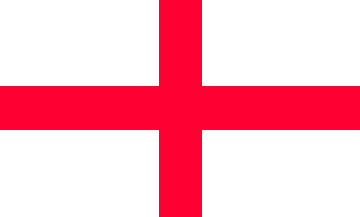 |
 |
|
part 2 |
|
LONDON |
|||
Monday 1 December 2008 We take the Underground
and struggle through the massively busy morning rush hour to
Faringdon Station. Trains are filled to capacity (and more),
but it is a relatively short ride. At Farringdon we have
arranged to meet David
Thompson. He is a certified (Blue Badge) guide, who
will guide us through From the tube station we
first walk to the Clerk's Well, giving the area its name.
The well was discovered in the 17th century. It is only
recently that the well is marked by a sign in a facade and
we are able to peek through a window into a dark hole.
Opposite the well are the editorial offices of the quality
newspaper The
Guardian. We walk on towards the St
James kerk. This church is built on the grounds
of a former Benedictine monastery, that was dissolved during
the reign of Henry VIII. The church is a replacement for the
origianal monastic chapel. The church is closed to visitors,
but David is able to open all doors. The church has a rather
austere interior and has more seat on a balcony. The area
has had quite a radical past. A few
We walk towards the
Barbican, the only post war residential complex in the City
of London from 1970. At first glance it looks a bit grim. It
is an intricate complex of blocks and towers interconnected
by bridges, tunnels and staircases. The four corners are
marked by tall tower blocks. Surprisingly enough despite the
many corners, dark alleyways and such the complex has not
fallen victim to petty crime, dirt and vandalism, on the
contrary: occupants try to enliven the place by putting up
flower boxes on their large balconies. The Northern Irish
football star George Best lived here once and compared it
to Colditz, but it said so many things and was rarely
sober. The location is called Cripplegate and was heavily
bombed during the Blitz. The only
remnants of the past are parts of the city wall and the
early Tudor St
Giles-without-Cripplegate We leave the Barbican
via Silk Street and north throuhg Bunhill Row to Bunhill
Fields. That was once a dump for victims of the plague and
became later a burial ground for non comformists, i.e.
Christians not belonging to the Church of England.
Most famous dead here are the poet William Blake and
the writer Daniel Dafoe (of Robinsoe Crusoe). We now enter
Hoxton. On the other side of the Fields is Wesley's
Chapel and House. It is the focal point for
Methodists world wide. Here John Wesley started with his own
congregation in a foundry next to the present building. In
1738 he was kicked out of the Church of England and was in
for a lot of bother with the authorities after that. When he
died he left behind a movement with 350 churches and 130.000
followers in the UK alone. The chapel was designed by George
Dance in 1778. In 1951 one Margareth Hilda Roberts married
here the divorcee Dennis Thatcher. Via Leonard Street and
Paul Street we walk past Expectations,
the largest and best known men's Men Leather and Rubber shop
of old, with an extensive line of clothes, toys and
accessories. We turn into Charlotte Road and through myriad
of narrow streets lined with pubs and restaurants we get to
Old Street which we cross and walk on to Hoxton Square the
beating heart of the new Hoxton as a centre for modern art.
Most striking is the White
Cube
Gallery, considered to be a kind of After lunch we take the
underground back to the B&B. After a short break we are
on our by 3pm. We take the underground to Blackfriars. We
walk a bit westward to the Millennium Bridge. This
is the first exclusive footbridge across the Thames in
London and the first bridge to be built in a century or so.
It is designed by the sculptor Caro and the famous architect
Sir Norman Foster. It got to a rocky start in 2000. The
bridge was almost immediately closed because it bounced to
much. That problem has been resolved and the bridge now
forms the perfect approach to the Tate
Modern, the museum for modern art on the south
bank of the Thames. When you are half way you must turn
round for a great view on St Paul's cathedral. Weather: sunny and cold: 6 degrees. A little drizzle at the end of the day. Tuesday 2 December 2008 We start with coffee
again at La
Bottega and the cute waiter, who fortunately does not
show himself much this morning. We take the underground to
Westminster, cross the bridge to the south bank where we
start a walk along the river Thames following the Thames
Path. This is We cross the nice, but
narrow Albert Bridge to Chelsea where we catch a bus to
Victoria Station. From there we take the tube to Tottenham
Court Road. We have lunch near the tube station and walk on
to the British
Museum. The British After that we set course
to the Egyptian department for the Rosetta stone.
This stone was uncovered by Napoleon's troops in Egypt in
1799 Later we take the tube to Charing Cross. We have a drink in Kudos bar. After that we walk to Mon Plaisir in Monmouth Street for a pre-theatre dinner. It is a small French bistro, where can get a table without a reservation, but with some luck. The place - said to be the oldest French restaurant in London - is full of French memorabilia. The theatre dinner is served at a high pace and is a bargain. After that we walk to the Lyceum theatre in Wellington Street on the corner of the Strand. Here we will see the musical The Lion King. The Lyceum is a classical English theatre, but the crowd is and behaves rather out of style. Many have brought a picnic and they are not very quiet either. The show is good and professionally staged, although a few actors were not gifted with the best of voices. A nice touch was the way they solved the problem of acting animal characters. The story line follows Disney's animation film fairly faithfully. After the show we return to the B&B. Weather: sunny start, but rain starts around midday. Dry later on. 4-6 degrees Wednesday 3 December 2008After breakfast and
coffee we take a bus to
Hyde Park Corner and walk a bit through the
park. A Christmas fun fair has been set up and the fake
German atmosphere is hard to miss. There is hardly any one
there yet, because it is We walk to Harrods
on Brompton Road. The biotope for the well heeled carreer
shopper. On each visit this department store manages to
impress. The offer of goods is overwhelming. With 18.000m²
of shopping surface and 330 departments it unequalled in the
world. London's number two, Selfridges, has only a third of
its space. Harrod's was founded in 1834 in the East
End by Charles Henry Harrod as a wholesaler in groceries,
specialising in teas. In order to be able to profit from the
great exhibition in Hyde Park - and to escape from the
poverty in the East End - Harrod moved in 1851 to
Knightsbridge to the spot of the present store. In 1898
Harrod's installed the first escalator in the world. The
present building was finished in 1905 according to a
design by Charles William Stephens. Of you can buy a
lot of things much cheaper elsewhere, but then you do not
get the precious green carrier bag to go with it. Some
depatments are sight in their own right. Both
architecturally and in terms of merchandise. Especially the
Food Hall is unsurpassable with its nice tiling and the
tempting oyster counter. We buy some filled chocolates
and Harrod’s special blend coffee. Ground
freshly for us. “How are you going to prepare it?” we are
asked professionally. Filter is the anstwer. "Then I will
grind it for filter". On our way to the men's wear we pass
the wax image of Mohammed
Al Fayed, the Egyptian multi billionaire owner of this
British icon… and almost the father-in-law to Princess
Diana. For Dodi and Di he has had We walk a few blocks down the street to Knightsbridge and competitor Harvey Nichols opposite the tube station. Harvey is a fair bit smaller, indulges less in old world prestige, but is even a bit pricier and far more progressive in its fashion. Harvey Nicks draws a younger, trendier crowd. Here too everything looks very well presented on the men's and ladies' departments as well as the food hall. We have already tried the Fifth floor restaurant in their branches in Leeds en Edinburgh. I buy a woolen hat by Y3, the trendy brand of Adidas. Benjamin Harvey started a linnen shop in 1813 on the corner of Knightsbridge and Sloane Street. He left the shop to his daughter on condition she would merge with Kolonel Nichols, who traded in oriental carpets, silk and luxury goods. The present store was opened around 1880 and extended in 1932. The chain (with branches in bigger UK cities, Dublin, Ryad, Dubai and Istanbul since 1996) has been in the hands of Hongkong businessman Dickson Poon since 2003. We take a bus back to Victoria, collect our suit case at the B&B and go for lunch at Pret-a-Manger, a healthy fast food, with branches all over London (just like competitor EAT.). Sandwiches and wraps and healthy juices is their specialty. We then take the underground in the direction of London City Airport. First we take the Circle Line to Westminster, where we change to the Jubilee Line to Canning Town. There we take the wrong (unmanned) train of Docklands Light Railway (DLR). It takes four stops for us to figure it out. Back again and then with the right train to the airport. We drop off the suit case (we are already checked in) and go through security. We hang around the departure lounge for a while before we can board the Fokker 50 to Rotterdam. 50 minutes later we are back in Rotterdam and just half an hour later back home.
|
|||
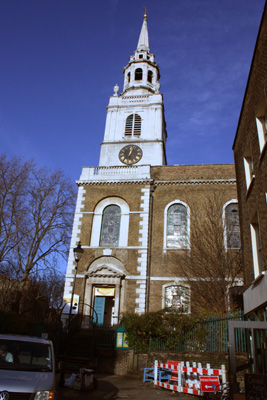 Clerkenwell en Hoxton today. Clerkenwell is
situated North of the City of London and was first populated
by Huguenots in the 17th century after the great fire. They
were trying to circumvent the closed guild system in the
City. Those were the days that a well was discovered, making
Clerkenwell a spa for a century or so. In the 19th century
Irish and Italian immigrants settle here and the population
tripples. It becomes a slum, which is sanitized during the
Victorian age. Some residential parts still remain though.
These days the area draws a more creative crowd and has a
lively pub and restaurant culture. Traditional trades of the
area (watchmaking, locksmith, printing and jewelry) are
still present here and there, but new activities include
media, design furniture and quality cooking.
Clerkenwell en Hoxton today. Clerkenwell is
situated North of the City of London and was first populated
by Huguenots in the 17th century after the great fire. They
were trying to circumvent the closed guild system in the
City. Those were the days that a well was discovered, making
Clerkenwell a spa for a century or so. In the 19th century
Irish and Italian immigrants settle here and the population
tripples. It becomes a slum, which is sanitized during the
Victorian age. Some residential parts still remain though.
These days the area draws a more creative crowd and has a
lively pub and restaurant culture. Traditional trades of the
area (watchmaking, locksmith, printing and jewelry) are
still present here and there, but new activities include
media, design furniture and quality cooking. 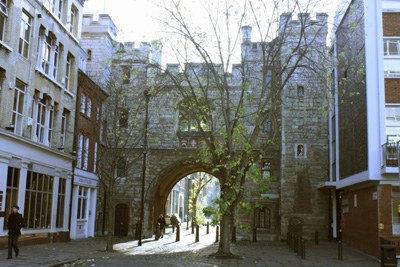 streets
from
here the Labour Party was founded in 1900 and the Communist
Party had its headquarters here for decades and printed its
newspaper Daily Worker. We continue and get to
Clerkenwell Green. This was once the epicentre of radical
London and focal point for demonstrations and riots, like
the Clerkenwell riot of 1832, in which an officer of the
newly established metropolitan police force was stabbed to
death. In 1890 the first May Day parade started here.
At nr. 37 is the
streets
from
here the Labour Party was founded in 1900 and the Communist
Party had its headquarters here for decades and printed its
newspaper Daily Worker. We continue and get to
Clerkenwell Green. This was once the epicentre of radical
London and focal point for demonstrations and riots, like
the Clerkenwell riot of 1832, in which an officer of the
newly established metropolitan police force was stabbed to
death. In 1890 the first May Day parade started here.
At nr. 37 is the 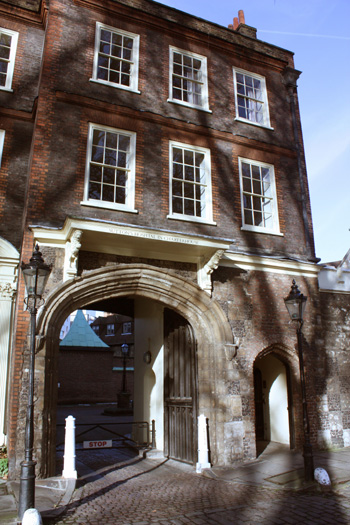 A
bit further down is Charterhouse, founded in 1371 as
a carthusian monastery. The boarding school for boys that
made the foundation famous moved to Surry in 1872, but to
this day a group of forty odd elderly men, is still cared
for here, referring to themselves as f "Brothers". The gate
house on Charterhouse Square has retained much of its
medieval charm. After the dissolution of monasteries by
Henry VIII Charterhouse was rebuilt as a mansion in Tudor
style. On the same square is Florin Court, an Art Deco
appartement building from 1936. The building was used as the
fictional home of Hercule Poirot in the tv series. Via
Charterhouse Street we walk to the Smithfield Meat
Market. The present building is dates back to 1868 and
was designed by Horace Jones, who also made the design for
the Tower Bridge. This is still the premier wholesale meat
market for London. To see it in action we would have had to
rise a little earlier as most of the action starts around
4am and end before 9am. A special exemption allows pubs to
open that early in the morning around here. Once Smithfield
was the site for public executions, like the one of the
Schottish hero William Wallace or Braveheart in 1305
and of many protestants under the rule of Bloody Mary
who were burnt here at the stakes. Commemorative
plaques in the wall of
A
bit further down is Charterhouse, founded in 1371 as
a carthusian monastery. The boarding school for boys that
made the foundation famous moved to Surry in 1872, but to
this day a group of forty odd elderly men, is still cared
for here, referring to themselves as f "Brothers". The gate
house on Charterhouse Square has retained much of its
medieval charm. After the dissolution of monasteries by
Henry VIII Charterhouse was rebuilt as a mansion in Tudor
style. On the same square is Florin Court, an Art Deco
appartement building from 1936. The building was used as the
fictional home of Hercule Poirot in the tv series. Via
Charterhouse Street we walk to the Smithfield Meat
Market. The present building is dates back to 1868 and
was designed by Horace Jones, who also made the design for
the Tower Bridge. This is still the premier wholesale meat
market for London. To see it in action we would have had to
rise a little earlier as most of the action starts around
4am and end before 9am. A special exemption allows pubs to
open that early in the morning around here. Once Smithfield
was the site for public executions, like the one of the
Schottish hero William Wallace or Braveheart in 1305
and of many protestants under the rule of Bloody Mary
who were burnt here at the stakes. Commemorative
plaques in the wall of  Britain.
The
gate was rediscovered after a bombardment by a Zeppelin in
1916, during world war I. After the reformation the
church was badly neglected. The main chapel was even used a
printer's shop, where Benjamin Franklin briefly worked
before moving to America. From 1887 the remains of the
church were carefully restored. Old elements remain among
which the tomb of Rahere, founder of the church. Around the
corner on Cloth Fair is the one time house of
SirJohn Betjeman (1906-84), the former Poet Laureate.
Britain.
The
gate was rediscovered after a bombardment by a Zeppelin in
1916, during world war I. After the reformation the
church was badly neglected. The main chapel was even used a
printer's shop, where Benjamin Franklin briefly worked
before moving to America. From 1887 the remains of the
church were carefully restored. Old elements remain among
which the tomb of Rahere, founder of the church. Around the
corner on Cloth Fair is the one time house of
SirJohn Betjeman (1906-84), the former Poet Laureate. 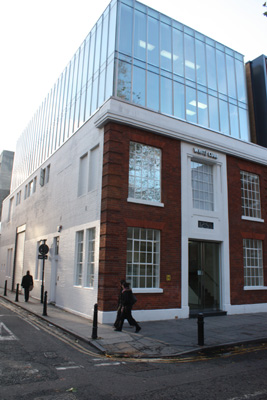 church. This is where Oliver Cromwell got married in 1620.
The church is now totally surrounded by the complex in the
middle of artificial lakes opposite the
church. This is where Oliver Cromwell got married in 1620.
The church is now totally surrounded by the complex in the
middle of artificial lakes opposite the  mini Tate Gallery, because of its form, but also it displays
work by similar artists. We say goodbye to our guide David
and go for lunch at
mini Tate Gallery, because of its form, but also it displays
work by similar artists. We say goodbye to our guide David
and go for lunch at 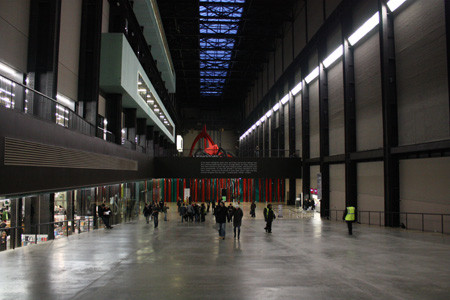 And
if
we look a bit further west we see the characteristic high
rises of the City, among them the Swiss Re building, or
And
if
we look a bit further west we see the characteristic high
rises of the City, among them the Swiss Re building, or
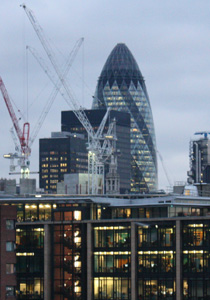 you in to the gigantic turbine room. This has been left
rather empty. The museum has 7 floors and can be visited
free of charge, with the exception of special exhibitions.
We visit only the exhibitions made up of works from the
museum's own collection. . The collection is rearranged
regularly according to themes. Periods or styles are not
important here and the themes are a bit idiosyncratic. Most
of the big names in modern art are present like Monet (water
lillies), Rothko (Seagram Murals), Miró, Margritte, Picasso,
Mondriaan, Joseph Beuys, Giacometti, Francis Bacon, Hockney
etc. After an hour and a half of strolling through the rooms
we take the tube from Southwark (longish walk there) to Soho,
where we have a beer in the Loft, a quiet gay bar on Rupert
Street. After that we have dinner in
you in to the gigantic turbine room. This has been left
rather empty. The museum has 7 floors and can be visited
free of charge, with the exception of special exhibitions.
We visit only the exhibitions made up of works from the
museum's own collection. . The collection is rearranged
regularly according to themes. Periods or styles are not
important here and the themes are a bit idiosyncratic. Most
of the big names in modern art are present like Monet (water
lillies), Rothko (Seagram Murals), Miró, Margritte, Picasso,
Mondriaan, Joseph Beuys, Giacometti, Francis Bacon, Hockney
etc. After an hour and a half of strolling through the rooms
we take the tube from Southwark (longish walk there) to Soho,
where we have a beer in the Loft, a quiet gay bar on Rupert
Street. After that we have dinner in 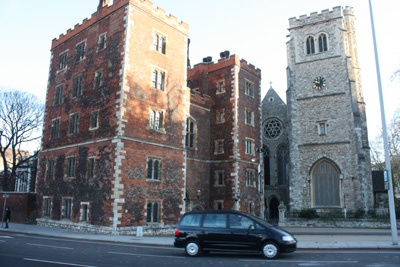 is a marked route from Oxford to the estuary of the river.
We walk upstream to Putney. We start on the wide walkway on
the embankment with great views of the Palace of
Westminster, where the houses of the British
parliament meet. It is a beautiful sight in the early
morning winter sun. After a while we pass Lambeth Palace,
the seat of the
is a marked route from Oxford to the estuary of the river.
We walk upstream to Putney. We start on the wide walkway on
the embankment with great views of the Palace of
Westminster, where the houses of the British
parliament meet. It is a beautiful sight in the early
morning winter sun. After a while we pass Lambeth Palace,
the seat of the  International Maritime Organisation (IMO) on our left. This
is an UN organisation looking after maritime issues. In its
facade we see a ships bow sticking out. After a while we get
to Vauxhall Bridge. On the left on the southbank is the
rather robust building of
International Maritime Organisation (IMO) on our left. This
is an UN organisation looking after maritime issues. In its
facade we see a ships bow sticking out. After a while we get
to Vauxhall Bridge. On the left on the southbank is the
rather robust building of 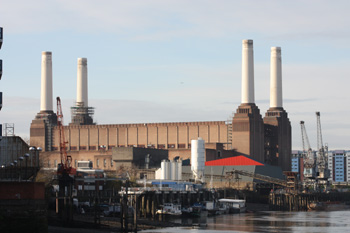 have
to
detour a bit away from the river bank, but soon we can
rejoin the river. In the distance we see the
have
to
detour a bit away from the river bank, but soon we can
rejoin the river. In the distance we see the  Museum is one of the greatest and most impressive museums in
the world. Its collection of Greek and Egyptian antiquities
has no equal. Its origins lie in the collection of 80,000
pieces of one Hans Sloane, a physician from Chelsea, who
left them in 1753 to King George II in exchange for £20,000.
The king was unable to pay and so the unwilling government
paid for it instead and accommodated it in a building
financed out of the proceeds of a controversial lottery.
After that the museum started gathering antiquities on an
unparalleled scale. The Greek sculptures that Elgin took
with him from Athens are world famous and the victory of
Napoleon gave access to the treasures that the French had
plundered in Egypt. Its own archeologist were up to their
tricks too en roamed all the major archeological sites world
wide. The building is grand and offers almost 4km of
exhibition space. It is a neoclassical building by Robert
Smirke. After the British Library left in the 1990s the
inner court got a new roof, designed by Norman Foster. In
the middle is still the old Reading Room, where Karl Marx
penned down his magnus opus Das Kapital. We limit ourselves
to the highlights. We go straight for room 18 with the
Elgin Marbles. Lord Elgin took the fries with him in
1801 from the Parthenon in Athens after a vague
understanding with the local Turkish commander. Maybe it was
for the better, as the Turks were less than careful with the
Greek Heritage. They used the Parthenon as a gun powder
storage, with disastrous consequences. Elgin put the marbles
in a shed behind his house near Pall Mall until he had to
sell them to the government in order to settle a tax debt of
£35,000 af te lossen. The government in its turn donated
them to the BM. The exhibition is beautiful and the statues,
if not totally unscathed are impressive.
Museum is one of the greatest and most impressive museums in
the world. Its collection of Greek and Egyptian antiquities
has no equal. Its origins lie in the collection of 80,000
pieces of one Hans Sloane, a physician from Chelsea, who
left them in 1753 to King George II in exchange for £20,000.
The king was unable to pay and so the unwilling government
paid for it instead and accommodated it in a building
financed out of the proceeds of a controversial lottery.
After that the museum started gathering antiquities on an
unparalleled scale. The Greek sculptures that Elgin took
with him from Athens are world famous and the victory of
Napoleon gave access to the treasures that the French had
plundered in Egypt. Its own archeologist were up to their
tricks too en roamed all the major archeological sites world
wide. The building is grand and offers almost 4km of
exhibition space. It is a neoclassical building by Robert
Smirke. After the British Library left in the 1990s the
inner court got a new roof, designed by Norman Foster. In
the middle is still the old Reading Room, where Karl Marx
penned down his magnus opus Das Kapital. We limit ourselves
to the highlights. We go straight for room 18 with the
Elgin Marbles. Lord Elgin took the fries with him in
1801 from the Parthenon in Athens after a vague
understanding with the local Turkish commander. Maybe it was
for the better, as the Turks were less than careful with the
Greek Heritage. They used the Parthenon as a gun powder
storage, with disastrous consequences. Elgin put the marbles
in a shed behind his house near Pall Mall until he had to
sell them to the government in order to settle a tax debt of
£35,000 af te lossen. The government in its turn donated
them to the BM. The exhibition is beautiful and the statues,
if not totally unscathed are impressive.  . It holds a text in hieroglyphs together with a translation
in Greek and old Egyptian. The stone provided the key to the
deciphering of the hieroglyphs, of which scientist had until
than believed that it was a kind of comic strip. The
Frenchman Champollion was the one who in the end found the
way to decipher the hieroglyphs. Then it is time for
mummies. On the first floor the BM has a collection of mummies,
putting all others to shame. Apart from human mummies we see
also mummified animals like monkeys, cats and crocodiles.
There are beautifully decorated sarcophaguses on display. We
want to go to the Lewis chessmen, of which we have
seen a few already last year in Edinburgh, but the room is
under reconstruction. The chessmen are of Norwegian origin
and were discovered on the Isle of Lewis in the outer
Hebrides in Scotland. We enjoy once more the grand inner
court before we leave and go back to the B&B.
. It holds a text in hieroglyphs together with a translation
in Greek and old Egyptian. The stone provided the key to the
deciphering of the hieroglyphs, of which scientist had until
than believed that it was a kind of comic strip. The
Frenchman Champollion was the one who in the end found the
way to decipher the hieroglyphs. Then it is time for
mummies. On the first floor the BM has a collection of mummies,
putting all others to shame. Apart from human mummies we see
also mummified animals like monkeys, cats and crocodiles.
There are beautifully decorated sarcophaguses on display. We
want to go to the Lewis chessmen, of which we have
seen a few already last year in Edinburgh, but the room is
under reconstruction. The chessmen are of Norwegian origin
and were discovered on the Isle of Lewis in the outer
Hebrides in Scotland. We enjoy once more the grand inner
court before we leave and go back to the B&B. 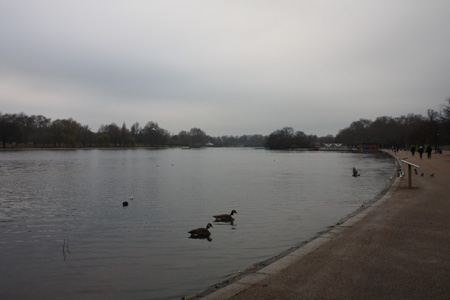 still
early
and freezing. We continue a bit along the the Serpentine
lake, which was created when a side stream of the Thames was
dammed off in 1730. There is a tea house here and it is
possible to rent rowing boats. We walk further along New
Ride and pass the Hyde Park Barracks, just when the a group
of members of the
still
early
and freezing. We continue a bit along the the Serpentine
lake, which was created when a side stream of the Thames was
dammed off in 1730. There is a tea house here and it is
possible to rent rowing boats. We walk further along New
Ride and pass the Hyde Park Barracks, just when the a group
of members of the 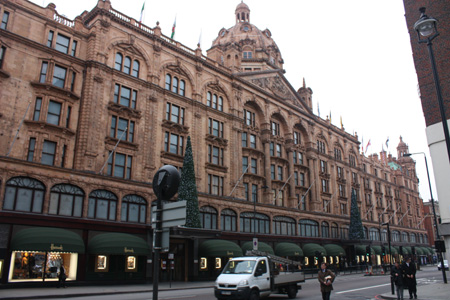 memorial founted installed. The men's wear is a bit on
the conservative side, not to say boring. Also kitchen ware
and china are very old school, with a few modern touches
here and there. The Egyptian staircase is a real sight. It
brings us to the Luxury Washrooms on the first
floor, where you can spray yourself with a wide choice of
fine perfumes and Eaux de Toilette for free.
memorial founted installed. The men's wear is a bit on
the conservative side, not to say boring. Also kitchen ware
and china are very old school, with a few modern touches
here and there. The Egyptian staircase is a real sight. It
brings us to the Luxury Washrooms on the first
floor, where you can spray yourself with a wide choice of
fine perfumes and Eaux de Toilette for free.